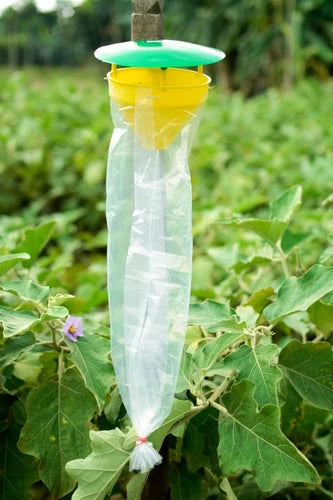
Beginner's Guide to Pheromone Traps
Share
Introduction
In recent years, agricultural practices have been evolving to embrace more sustainable and eco-friendly methods. One such innovation gaining traction is the use of pheromone traps. These traps offer a targeted approach to pest management, effectively reducing reliance on chemical pesticides while maintaining crop health. In this blog, we'll delve into what pheromone traps are, and their benefits, and provide a step-by-step guide on how to set them up on your farm.
Understanding Pheromone Traps
What are Pheromone Traps?
Pheromone traps utilize the natural mating behaviors of insects. Pheromones are chemical substances emitted by insects to communicate with others of the same species. By strategically placing traps baited with synthetic versions of these pheromones, farmers can disrupt the mating cycle of pests. This method helps to monitor and control pest populations without resorting to broad-spectrum pesticides that can harm beneficial insects, wildlife, and even humans.

Benefits of Pheromone Traps
Precision Targeting: Pheromone traps specifically attract male insects of a targeted species, reducing the need for blanket pesticide
Reduced Environmental Impact: By minimizing pesticide use, pheromone traps help preserve beneficial insects like pollinators and natural predators.
Cost-Effective: While initial setup costs may be involved, pheromone traps can lead to long-term savings by reducing pesticide purchases and potential crop
Residue-Free: Unlike chemical pesticides, pheromone traps leave no harmful residues on crops, ensuring produce meets stringent safety.

Step-by-Step Guide to Setting Up Pheromone Traps
Step 1: Identify Target Pests Begin by identifying the specific pests affecting your crops. Common pests controlled with pheromone traps include moths, beetles, and fruit flies.
Step 2: Choose Appropriate Trap Types There are different types of pheromone traps designed for specific pests. Select traps based on the pest species, crop type, and farm layout. Traps can vary from sticky cards for flying insects to delta traps for moths.
Step 3: Determine Trap Placement Placement is crucial for trap effectiveness. Position traps near pest entry points or in areas where pests are likely to gather. Follow manufacturer guidelines for trap density based on crop size and pest density.
Step 4: Install Traps Correctly Ensure traps are installed at the right height and orientation. Traps should be easily accessible for monitoring and maintenance. Replace pheromone lures as recommended to maintain trap efficacy
Step 5: Monitor Trap Results
Regularly check traps to monitor pest populations. Record and analyze trap catches to assess pest pressure and determine if additional traps or actions are needed.
Step 6: Integrate with Farm Management Practices
Incorporate pheromone traps into your integrated pest management (IPM) strategy. Combine traps with cultural practices, biological controls, and other non-chemical methods for comprehensive pest management.
Step 7: Evaluate Effectiveness
Periodically evaluate the overall effectiveness of pheromone traps in reducing pest damage. Adjust trap placement and type as needed based on seasonal changes and pest dynamics.

Conclusion
Pheromone traps represent a sustainable solution to pest management, aligning with modern agricultural practices focused on environmental stewardship and food safety. By adopting pheromone traps on your farm, you can minimize pesticide use, protect natural ecosystems, and produce healthier crops. Embrace this innovative approach and contribute to a greener future for agriculture.
Integrating pheromone traps into your farming practices requires careful planning and monitoring, but the benefits extend far beyond your fields. Start small, observe results, and scale up as you gain confidence in this effective pest management tool. Join the movement towards sustainable agriculture with pheromone traps and pave the way for a more resilient farming future.
